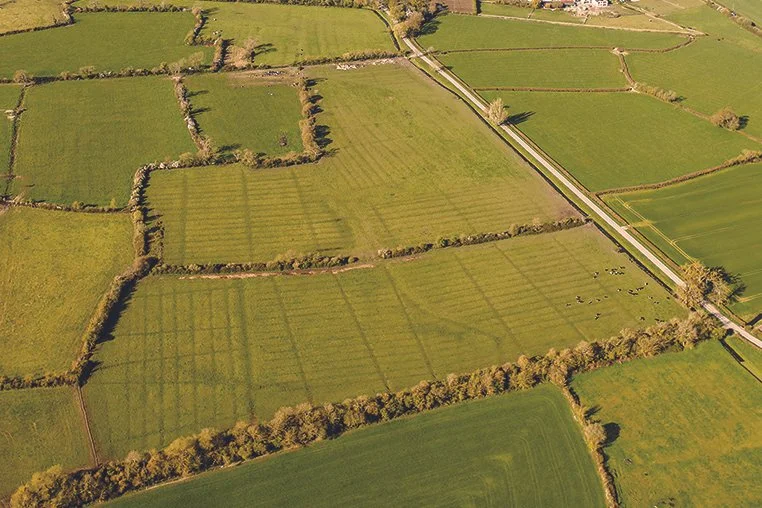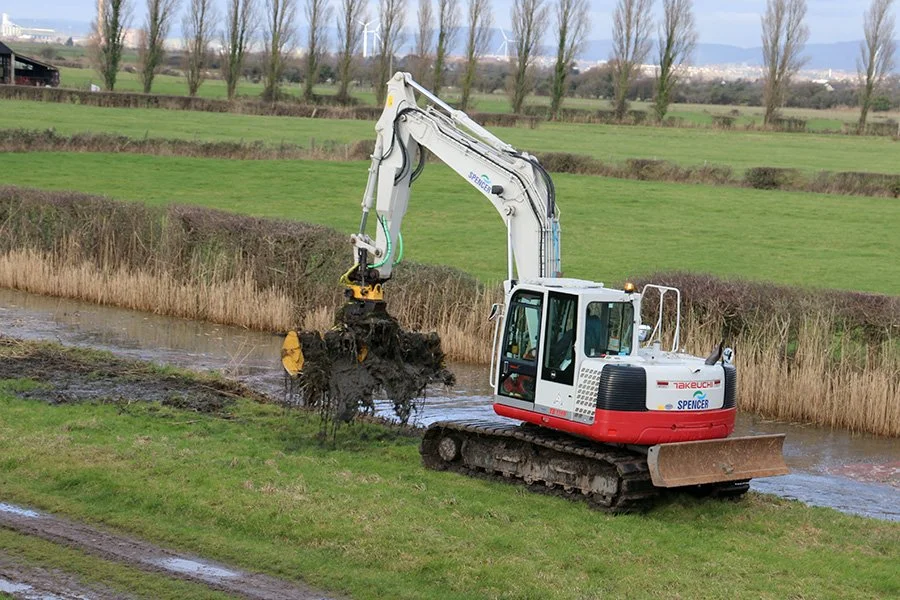Water Management
Chapel Reen (C Harris)
There are approximately 870 miles of reens and ditches on the Levels; laid end-to-end, they would stretch from Land’s End to John O’Groats.
During the wet winter months, they perform the important function of quickly draining water from the land to the estuary, thus preventing or reducing the risk of flooding. During the summer, the flow of water can be slowed, keeping water levels high and promoting the growth of grass for grazing animals.
Alongside their direct value to farmers and other landowners, the reens, ditches, wetlands and their margins are home to a wide range of plants and animals, such as frogbit, arrowhead, water voles, and dragonflies.
Without management, silt, leaf-litter and woody debris gradually accumulate in the reens and ditches and they lose their ability to transport water. Eventually, they can become dry, overgrown by hedges and scrub, or lost completely.
Watch ‘Life Down the Drain’, a short introduction to drainage on the Levels:
Reens, Ditches and Grips
The importance of water management on the Levels cannot be overemphasised, a well-managed system of reens, ditches and grips reduce the risk of properties and fields flooding. This will become ever more pressing with climate change, the resulting rise in sea levels and an increase in the frequency of storm events. A well-managed and functioning system is more resilient to these extreme flood events.
Traditional field drainage is made up of grips, field ditches, Internal Drainage District (IDD) reens and main reens. The main reens convey water to the Severn Estuary via tidal flaps. The field ditches were carefully constructed so that the system drains by gravity. Gwent Levels flora and fauna are dependent on water quality, quantity, and a connected diverse drainage system.
Water Quantity (Water Level Management)
Without enough water, the special features (both plants and invertebrates) of the Gwent Levels would be unable to complete their lifecycles. Natural Resources Wales (NRW), as the IDD, has responsibility for water level management.
Summer Penning Levels
During the summer the water levels are penned and water is stopped from draining into the estuary creating a static water body. This provides water for livestock, helps stabilise banks, provides irrigation, maintains field boundaries, and supports the wildlife in the watercourses.
Winter Penning Levels
In winter, the boards/sluices are removed or lowered, to allow the water to drain into the Estuary, preventing flooding. It also ‘flushes’ the nutrients accumulated over the summer months.
The drainage network is subject to varying periodic management to desilt and manage vegetation growth. NRW undertake maintenance works on main and IDD reens.
Main reens are desilted/cast out every 4 years, de-weeded every year and bankside vegetation is usually managed bi-annually.
IDD reens are desilted/cast out every 7 years, de-weeded every year and bankside vegetation is usually managed annually.
This staggered pattern of management is an essential part of maintaining water carrying and flood storage functions.
Connectivity and diversity of the drainage system
The drainage system of the Wentlooge Level and Caldicot Level form an interconnected drainage network of grips, field ditches and reens which vary in physical form. e.g. different water depths, from marginal to deep water, support a range of different species. These variations increase habitat diversity and contribute to the rich diversity of the Gwent Levels. Connectivity provides resilience to changing environmental conditions, including natural habitat succession, and enables species to recolonise ditches following management operations.
Grips
These form linear shallow depressions, which remain at least damp even in the summer. The different habitat conditions increases the diversity of plants and allows invertebrates to colonise these areas. The grips also help to maintain a high water table and stable hydrological regime, thereby reducing seasonal fluctuations that could dry out ditches.
Grips in a field near Redwick (Commission Air/Living Levels)
Elver Act
The movement of Elver (young eels) should not be impeded by any infrastructure e.g. a tidal flap. NRW no longer issue authorizations to commercially fish for eels or elver anywhere in Wales.
Re-casting/desilting
This involves the removal of silt and organic debris from the watercourse, ideally carried out periodically, to maintain functionality and safeguard the host of aquatic plants and invertebrates which need the open water to thrive.
The landowner has responsibility for the management of field ditches, (it is a requirement of cross-compliance, failure to comply may result in a reduction in farm support payments).
Field ditches should be desilted/ cast out every 7-10 years (or as necessary) and bankside vegetation managed at least once every 2 years.
Avoid clearing out (casting) too many adjacent /interconnected ditches in the same year to ensure that a mosaic of ditch succession is maintained across the Gwent Levels to enable the effective establishment of diverse wildlife communities. A mosaic of ditch succession is important to allow species e.g., water voles, to continue to move through the landscape.
Leave castings on the bankside so that less mobile species have the chance to recolonise the ditches. However, avoid leaving soil bare for long periods, especially over winter. These measures help limit soil erosion which results in a loss of nutrients and causes pollution and sedimentation problems in watercourses.
To avoid the restoration of field ditches becoming resource-heavy and problematic, any that have been cast must be maintained – particularly if fencing has been erected.
Further advice on field ditch management and SSSI consent can be obtained from NRW.
Re-casting ditch (C Harris)
De-weeding and flailing
Clearing of bankside vegetation, including the removal of scrubby growth along one side of the ditch, brambles, saplings, nettles, reeds and tall grasses; to keep the reens and ditches open to sunlight. This is beneficial for aquatic plants, especially those that are floating and submerged, water voles, and aquatic invertebrates. Banks should be cut at least every other year to prevent the hedge/scrub/brambles from growing up and over shading the ditch.
Buffer Strips or headlands
Keeping a strip of rough grassland (3 to 10m wide) at the edge of a silage field, for example, will better filter any runoff from the field before it gets into ditches/reens. Using buffers will minimise agricultural runoff, prevent soil erosion and spray drift. They also provide habitat for shrill carder bees and other terrestrial invertebrates.
Herbicide
Do not apply herbicide within 10 metres of any reen or ditch to prevent leachate from entering the drainage system through spray drift.
Separation and management of clean and dirty water on farms
Keeping appropriate infrastructure in place, e.g. guttering to allow the collection of clean water from roofs, reduces the volume of dirty water and makes it easier to deal with appropriately. This improves water quality, which affects all aquatic habitats. Pollution events have multiple impacts on freshwater habitats and their species. Advice and guidance on clean and dirty water management are available from Farming Connect: businesswales.gov.wales/farmingconnect/land/water
Invasive Non-Native Species
Be vigilant for invasive species, particularly floating pennywort, parrot feather, and the presence of red slider turtles. For more information on other INNS and action to take, see The Gwent Levels INNS booklet Invasive Non-Native Species.
Sustaining the Gwent Levels Project
Management of the waterways was a major part of both the Sustaining the Gwent Levels SMS project and the Living Levels Programme, working to restore these important waterways.
Management involved clearing scrub (from one side of the ditch), reducing shading of the waterway, tree pollarding, and clearing the silt from the reens and ditches so that there is open water, and it can run freely. This work is of huge benefit to the wildlife interest within the reens and ditches, as well as important for flood protection.


